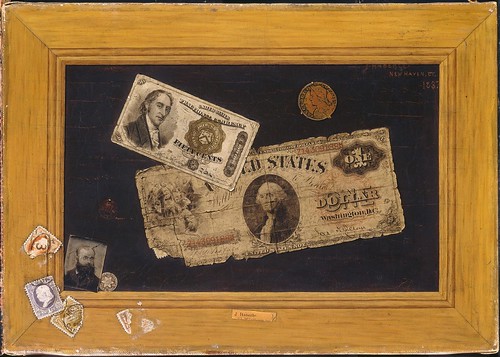
PREV ARTICLE
NEXT ARTICLE
FULL ISSUE
PREV FULL ISSUE
TROMPE L'OEIL MONEY ARTIST JOHN HABERLEArthur Shippee passed along a nice article about trompe l'oeil painter John Haberle. Thanks! See the complete article online and follow the links to view more Haberle works. -Editor
The small oil on canvas depicts several familiar objects including coins, paper currency and postage stamps, exactingly rendered in the then-fashionable trompe l'oeil ( Haberle then spent a year working as an engraver in Montreal, returning to New Haven in 1875 to set up his own studio on Winthrop Avenue. Soon he was doing illustrations for paleontologist Othniel Charles Marsh who, at the time, was preparing to open Yale's Peabody Museum as one of its original curators. Haberle was also enlisted by Marsh to repair fossils, arrange specimens and paint scenery for displays.
In his spare time, Haberle began the pursuit of a fine art career. His early watercolor, Yellow Canary (1883), now held at the Yale University Art Gallery, portrays a lifeless bird suspended in front of a cigar box top and evidences his budding interest in trompe l'oeil, a style the Philadelphia artist William Harnett had introduced to Americans in the previous decade. In 1883, Haberle became a founding member of the New Haven Sketch Club, where he taught regularly, and he applied for admission to the National Academy of Design in New York, which he attended the following year. By 1885, he was back in New Haven with a portfolio of paintings that employed what he then called his
His reputation quickly grew. In 1887, he submitted Imitation to the National Academy's fall exhibition. The painting, depicting bills, coins, stamps and a tintype of Haberle, soon prompted Harnett himself to declare that
By the 1890s, Haberle's paintings were so realistic that he was admonished by federal authorities to The financial success Haberle's work brought allowed him to purchase a parcel of land overlooking the harbor in Morris Cove, where he built a house and studio.
To read the complete article, see:
For more information on the works, see:
Wayne Homren, Editor The Numismatic Bibliomania Society is a non-profit organization promoting numismatic literature. See our web site at coinbooks.org. To submit items for publication in The E-Sylum, write to the Editor at this address: whomren@gmail.com To subscribe go to: https://my.binhost.com/lists/listinfo/esylum All Rights Reserved. NBS Home Page Contact the NBS webmaster 
|


